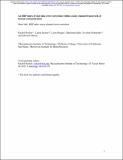An ERP index of real-time error correction within a noisy-channel framework of human communication
Author(s)
Ryskin, Rachel; Stearns, Laura; Bergen, Leon; Eddy, Marianna; Fedorenko, Evelina; Gibson, Edward; ... Show more Show less
DownloadSubmitted version (651.5Kb)
Publisher with Creative Commons License
Publisher with Creative Commons License
Creative Commons Attribution
Terms of use
Metadata
Show full item recordAbstract
Recent evidence suggests that language processing is well-adapted to noise in the input (e.g., spelling or speech errors, misreading or mishearing) and that comprehenders readily correct the input via rational inference over possible intended sentences given probable noise corruptions. In the current study, we probed the processing of noisy linguistic input, asking whether well-studied ERP components may serve as useful indices of this inferential process. In particular, we examined sentences where semantic violations could be attributed to noise-for example, in "The storyteller could turn any incident into an amusing antidote", where the implausible word "antidote" is orthographically and phonologically close to the intended "anecdote". We found that the processing of such sentences-where the probability that the message was corrupted by noise exceeds the probability that it was produced intentionally and perceived accurately-was associated with a reduced (less negative) N400 effect and an increased P600 effect, compared to semantic violations which are unlikely to be attributed to noise ("The storyteller could turn any incident into an amusing hearse"). Further, the magnitudes of these ERP effects were correlated with the probability that the comprehender retrieved a plausible alternative. This work thus adds to the growing body of literature that suggests that many aspects of language processing are optimized for dealing with noise in the input, and opens the door to electrophysiologic investigations of the computations that support the processing of imperfect input.
Date issued
2021Department
Massachusetts Institute of Technology. Department of Brain and Cognitive Sciences; McGovern Institute for Brain Research at MITJournal
Neuropsychologia
Publisher
Elsevier BV
Citation
Ryskin, Rachel, Stearns, Laura, Bergen, Leon, Eddy, Marianna, Fedorenko, Evelina et al. 2021. "An ERP index of real-time error correction within a noisy-channel framework of human communication." Neuropsychologia, 158.
Version: Original manuscript